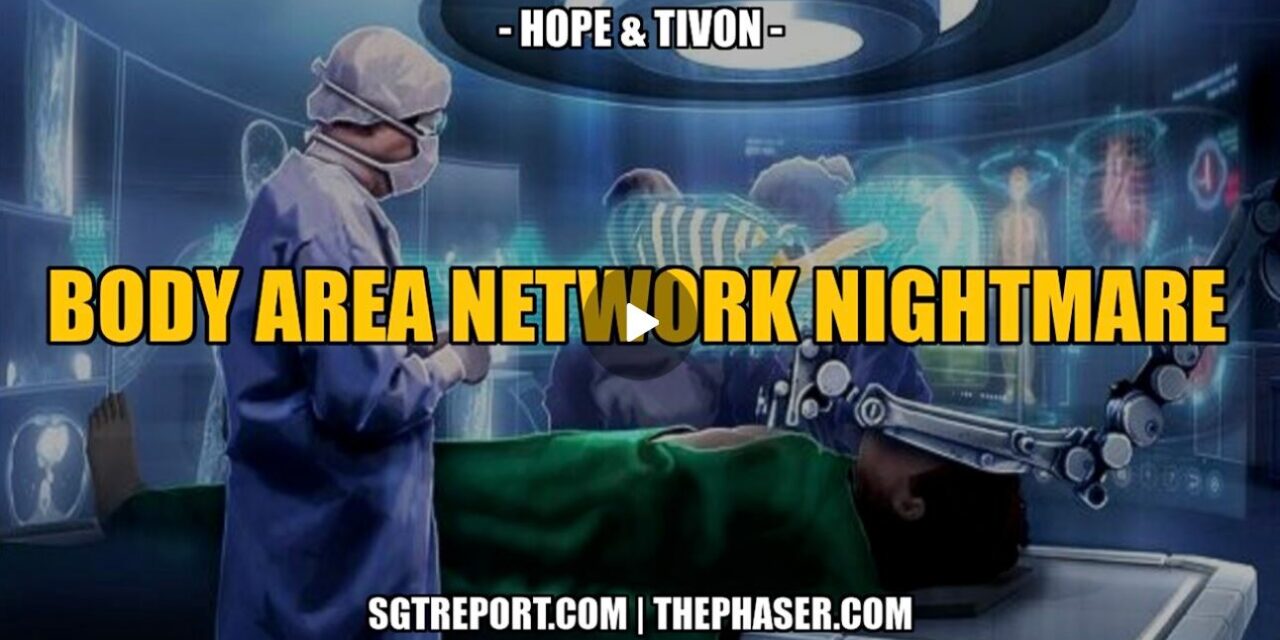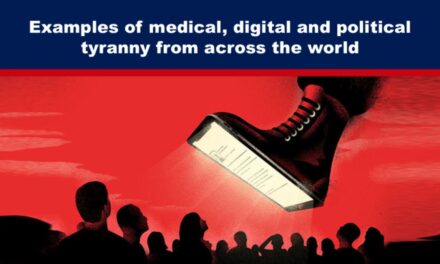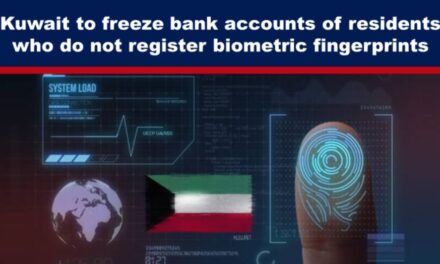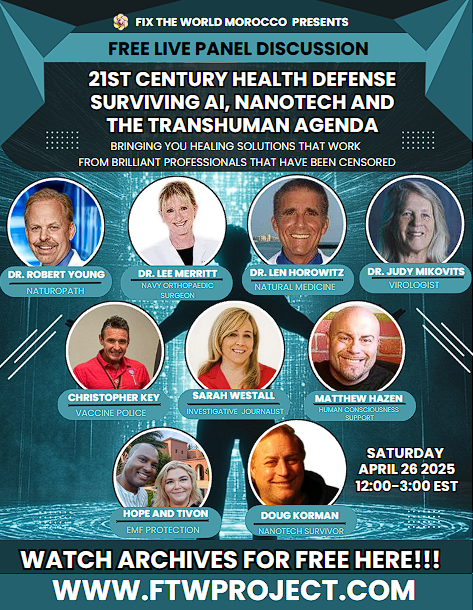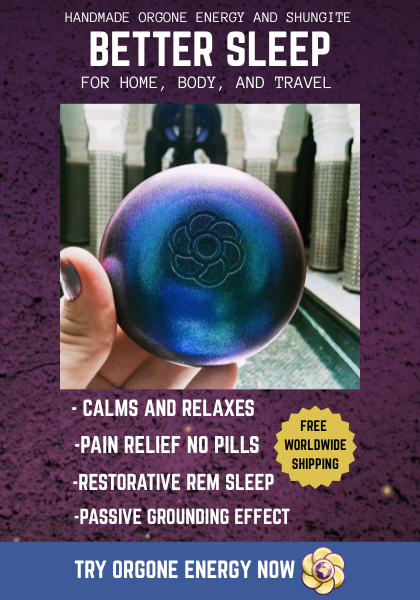My good friends and researchers Hope & Tivon are back with the TRUTH about transhumanism and the horror of the body area network which is rolling out as the brave new future of “medicine”, but in truth it’s the track and trace kill box they need to enslave humanity in their evil web.
Source: https://rumble.com/v4o4qgh-must-hear-the-body-area-network-nightmare-hope-and-tivon.html
Get our EMF Protection Products Here: https://ftwproject.com/ref/6/
For the Slides from the Show: Download them Here:
Medical Body Area Network Nightmare
Show Notes:
Medical Body Area Network
Biosensors and Wake up Radio
Metamaterials for Electromagnetic Control
Wireless Drugging and the Digital Nervous System
Telehealth Technology and Remote Health Monitoring
How they Use Biosensor Networks to Track your Every Move in your house
Using the Internet of things to monitor your every move after COVID
Emerging Technology AI Precision Healthcare
Nvidia Smart City MBAN Hospital Setup
NVIDIA and AMD to run the Tech
Digital Twins in Healthcare
“You are now the Guinea Pig” Modernization Act
Bioluminescent Interface Why Peoples Faces are Glowing
Migrants from Emerging Tech Industry Coming to an American City Near You
You might say all of this medical technology is just intended for sick people, but no. They have been using technology to hack into peoples bodies to wirelessly drug people. And this has been made even easier for them to do since they upgraded their infrastructure in 2017 through what is called the cyber physical backbone for the 4th industrial revolution.
The technology has more laws allowing it to do whatever it wants to your body than you do. All the regulatory agencies have been very busy creating the legal structure for wBAN, MBAN, Wireless drugging, and patient compliance for many years now.
Passive Hardware Considerations for Medical Body Area Network Transceivers 2018
https://www.medicaldesignbriefs.com/component/content/article/29112-passive-hardware-considerations-for-medical-body-area-network-transceivers#:~:text=Passive%20Hardware%20for%20WBAN%20Transceivers,upon%20the%20application%20and%20environment.
This is a blog read by physicians, nurses, radiologists, anyone working in computer networking in a hospital, anyone working in local care facilities.
The FCC mandated the MBAN in 2014. MBAN is a Subset of the WBAN
FROM THE FCC WEBSITE
Connect2HealthFCC – Wireless Health and Medical Devices Background
https://www.fcc.gov/general/connect2healthfcc-wireless-health-and-medical-devices-background
Medical Body Area Networks (MBANs): In 2012, the FCC released an Order to allocate spectrum for Medical Body Area Networks (MBANs), making the U.S. the first country in the world to make spectrum available for this specific usage. MBANs are networks of wireless sensors, often no bigger than a Band-Aid, which can transmit data on a patient’s vital health indicators to their doctor or hospital. For more information, see the MBANs Fact Sheet and a listing of Frequency Bands for Medical Devices.
FCC Gives Medical Body Area Networks Clean Bill of Health Wireless monitoring devices will improve hospital care and make way for continuous home monitoring
https://spectrum.ieee.org/fcc-gives-medical-body-area-networks-clean-bill-of-health
THE FCC ALLOCATED SPECIFIC FREQUENCIES FOR THESE MEDICAL BODY AREA NETWORKS
The first use of MBANs will likely be in hospitals, but a longer term application could be remote monitoring devices that allow doctors to check on patients at home. FCC Chairman Julius Genachowski said the decision opened up “tremendous potential to untether patients from tubes and wires, and improve the quality of health care and ensure better outcomes for patients.”
Among the other benefits of MBANs:
The networks can potentially alert doctors to problems before the patient’s condition becomes critical, thus avoiding the need for acute intervention.
The lack of multiple wires makes it easier for hospital staff to move the patient, and gives the patient more freedom to walk around.
Hospital personnel or home caregivers can quickly add or remove sensors as medical conditions warrant.
MEDICAL BODY AREA NETWORK (MBAN)
In 2014, the FCC finalized the rules for MBANs — a network of sensors/actuators worn on the human body that communicate with a controlling device via a wireless link. With a spectrum allocation in the S-band from 2360 to 2400 MHz, the ruling states that the 2360–2390 MHz band is restricted to indoor use while the rest of band is open for use in other locations (e.g., residential). The MBAN is a subset of the more general trend of wireless body area networks (WBAN) or body sensor networks (BSN) that includes nonmedical applications such as human-computer interfaces (e.g., neural interface, virtual reality), location tracking, and personal fitness tracking).
MBAN is IN THE BODY IEEE 802.15.6
Fig. 1 – The IEEE 802.15.6 standard defines the PHY and MAC layers for both medical and nonmedical wireless body area networks (WBAN). 5
In 2012, the IEEE 802.15.6 standard was released to define the physical (PHY) and medium access (MAC) layers of the WBAN Open Systems Interconnection (OSI) model. The standard defines wireless communications with support for quality of service (QoS), low power, and data rates as high at 10 Mbps while being able to operate in licensed (i.e., WMTS, MICS, MBAN), and unlicensed (ISM) spectrum space. 2 The PHY layer comes with three options: narrowband (NB), ultra-wideband (UWB), and human body communications (HBC) (see Figure 1).\
Omnet is one of the most common WBAN softwares being used today. This is used in hospitals for all different types of WBANs, not just the MBANs. Wireless Sensor network Simulation. It shows a simulation to send data to nodes on a network, when you look at setting up the software on other training videos it shows you that the nodes on the network are actually human bodies.
Wireless Sensor Network Simulation using OMNET++ | WSN Projects using OMNeT++
https://www.youtube.com/watch?v=CwXZIDf8GyY
This video shows the network set up between different nodes, the nodes can be towers or the nodes can be human bodies.
wban Wireless Body Area Network Matlab Code Projects
https://www.youtube.com/watch?v=nPWKGlk35e0
When you see the wireless channel signal, or you see the channel modulation that professor Ian Aykildiz is always talking about, you understand that the air molecules are all over you, crawling on you, rearranging by magnetics and frequency your own blood stream and temperature. This is your terahertz networks operational and inside and on the body.
Toward Location-aware In-body Terahertz Nanonetworks with Energy Harvesting
https://www.researchgate.net/publication/363053978_Toward_Location-aware_In-body_Terahertz_Nanonetworks_with_Energy_Harvesting
Nanoscale wireless networks are expected to revolutionize a variety of domains, with significant advances conceivable in in-body health-care. These nanonetworks will consist of energy-harvesting nan-odevices passively flowing through the bloodstream, taking actions at certain locations, and communicating results to a more powerful Body Area Network (BAN). Assuming such a setup and electromagnetic nanocommunication in the Terahertz (THz) frequencies, we propose a network architecture that can support fine-grained localization of the energy-harvesting in-body nanonodes, as well as their two-way communication with the outside world. The main novelties of our proposal lie in the utilization of location-aware and Wake-up Radio (WuR)-based wireless nanocommunication paradigms, as well as Software-Defined Metamaterials (SDMs), for supporting the envisioned functionalities in THz-operating energy-harvesting in-body nanonetworks. We argue that, on a high level, the proposed architecture can handle a large number of nanonodes, while simultaneously dealing with a short range of THz in-body propagation and highly constrained nanonodes.
Wake Up Radio
Imagine a receiver in a very low power mode that would, in a magical way, wake up just in time for the data to be received.
Wake-Up Radio – A key component of IoT?
https://www.ericsson.com/en/blog/2017/12/wake-up-radio–a-key-component-of-iot
Software Defined Metamaterials
METAMATERIALS are artificial structures that enable the realization of novel electromagnetic (EM) components with engineered and even unnatural functionalities. Through the unprecedented control over electromagnetic waves, achieved thanks to the manipulation of impedance at subwavelength scale, metamaterials have led to significant breakthroughs in fields such as imaging, radar, or wireless communications [1]–[4] across the whole spectrum
Abstract— Metamaterials and their two-dimensional analogues, metasurfaces, have recently attracted enormous attention because of their powerful control over electromagnetic (EM) waves from microwave to visible range. Moreover, by introducing explicit control of its sub-wavelength unit cells, a metamaterial can become programmable. Programmable metamaterials may not only host multiple EM functionalities that can be chosen or combined through simple software directives, but also be provided with means to adapt to the environment or communicate with other metamaterials, thereby enabling a myriad of applications in sensing, imaging, or communications.
Programmable Metamaterials for Software-Defined Electromagnetic Control: Circuits, Systems, and architectures
https://upcommons.upc.edu/bitstream/handle/2117/192486/09007666(1).pdf
They support a network architecture that can support “fine grained localization”
Fine-grained recognition [1]–[7] refers to the task of distin- guishing sub-ordinate categories such as bird species [8], [9], dog breeds [10], aircraft [11], or car models [12], [13]. It is one of the cornerstones of object recognition due to the potential to make computers rival human experts in visual understanding.
http://vision.stanford.edu/pdf/icpr14.pdf
They are classifying cell structure at the nano scale and are using the same “stable diffusion” methods they use with AI. (chat GPT) This is all being done on the terahertz spectrum. This technology is being used to watch things at the nanoscale, to open and close cells bio-electrically at the level of the ion channel, using optigenetics and software defined metamaterial. Communicating from your skin deeper into your body, using computer networking in the body to tell the different nodes in your body what to do. Using your heart rate to drive, and using the pressure in your veins and arteries to scoot itself along.
Stable Diffusion:
Stable Diffusion is a deep learning, text-to-image model released in 2022 based on diffusion techniques. It is considered to be a part of the ongoing AI boom.
It is primarily used to generate detailed images conditioned on text descriptions, though it can also be applied to other tasks such as inpainting, outpainting, and generating image-to-image translations guided by a text prompt.[3]
https://en.wikipedia.org/wiki/Stable_Diffusion
WIRELESS SENSOR NETWORKS PAVING A PATH FOR MBAN TECHNOLOGY
Wireless sensor networks (WSN) are a nascent technology in the medical realm. Currently, WSNs are being heavily used in commercial applications such as smart homes with commercial off-the-shelf (COTS) transmit and receive modules such as ZigBee, Z-Wave, and XBee in the unlicensed 900 MHz and 2.4 GHz ISM bands. They are found in low power wide area networks (LPWAN) in both the unlicensed and licensed spectrum for long distance, smart city applications (e.g., smart lighting, smart meters, etc.). Industrial facilities have also used WSNs in industrial Internet of Things (IIoT) applications for tracking critical parameters around plants and manufacturing facilities.
The WSN attached to the body uses similar principles in a different piece of spectrum where sensor nodes are placed on and in various parts of the body for readings. In-body, or implantable, applications include glucose sensors, cardiac pacemakers, implantable cardioverter defibrillators (ICD), and endoscope capsules. On-body, or wearable, sensing applications include electrocardiogram (ECG), electroencephalography (EEG), body temperature tracking, blood SpO2 sensors, blood pressure sensors, respiratory rate monitors, spirometers, heart rate monitors, fetal heart rate monitors, and fall detection. By using relatively inexpensive sensor nodes, physiological information can be transmitted to medical servers in real time.
In hospitals and healthcare institutions, the sheer amount of patient metrics to track for the staff of doctors and nurses can be been a point of contention. Lawsuits based on the grounds of negligence are a risk that all healthcare practitioners take. Furthermore, there is an estimated 200,000 patients that die in the United States annually from medical errors. 1 Introducing wireless patient monitoring in these environments can potentially mitigate the risks that are innately involved in an environment geared at treatment and maintenance of sick people. There is always the potential for cyberattacks, but the rewards may outweigh the risks. Wired technologies limit patient mobility, increase the difficulty in transporting patients, and often introduce significant delays and hassle for the caregiver in arranging the cables.
With the patient monitoring market expected to hit $27 billion by 2020, wireless patient monitoring is poised to be a major part of that. According to Berg Insight, more than 3 million people worldwide were being monitored remotely by professional caregivers in 2013 — this is most likely from wireless medical services such as Medical Implant Communications Service (MICS) and Wireless Medical Telemetry Services (WMTS). WMTS is most often used for critical patient care whereas the more recently developed Medical Body Area Network (MBAN) technology can be used to simplify tracking biometrics in more routine patient care. moreover, MICS and WMTS small bandwidths do not support high data rate applications.
Improving the Security of the IEEE 802.15.6 Standard for Medical BANs
https://arxiv.org/pdf/2201.06354.pdf
ABSTRACT A Medical Body Area Network (MBAN) is an ensemble of collaborating, potentially heterogeneous, medical devices located inside, on the surface of or around the human body with the objective of tackling one or multiple medical conditions of the MBAN host.
These devices – which are a special category of Wireless Body Area Networks (WBANs) – collect, process and transfer medical data outside of the network, while in some cases they also administer medical treatment autonomously. Since communication is so pivotal to their operation, the newfangled IEEE 802.15.6 standard is aimed at the communication aspects of WBANs. It places a set of physical and communication constraints while it also includes association/disassociation protocols and security services that WBAN applications need to comply with.
DID YOUR GOVERNMENT OR DOCTORS EVER TELL YOU HOW YOU ARE CONNECTED TO THE “CLOUD” ??? – HERE IS HOW 👉 MBAN = Medical Body Area Networks
https://rumble.com/v3yngyj-november-29-2023.html
This is a bill that is passed that shows how they legislate paying companies for wireless drugging
Digital Therapeutics Alliance
DTA Applauds the Reintroduction of Bipartisan Legislation to Enable Public Coverage of Prescription Digital Therapeutics March 9,2023
https://dtxalliance.org/2023/03/09/dta-applauds-the-reintroduction-of-bipartisan-legislation-to-enable-public-coverage-of-prescription-digital-therapeutics/
The Access to Prescription Digital Therapeutics Act (S. 723 and H.R. 1458). Upon passage, this bill will enable public coverage of prescription digital therapeutics, defined in this bill as a product that uses software to achieve its intended result, is cleared or approved by the Food and Drug Administration (FDA) for the prevention, management, or treatment of a medical condition, and is authorized by a qualified, licensed clinician. If passed, the Access to Prescription Digital Therapeutics Act will establish a payment methodology for manufacturers of prescription digital therapeutics…
Electroceuticals (Miniature Neurostimulators)
Electroceuticals are broadly defined as medical devices that provide neurostimulation for therapy, but it is often used as a term to reference ultra-miniature and/or injectable implants. . The Electroceutical therapy involves mapping the neural circuitry and delivering neural impulses to these specific targets.
Electroceuticals in medicine – The brave new future
https://www.sciencedirect.com/science/article/pii/S0019483217308131#:~:text=Electroceuticals%20are%20a%20new%20category,administered%20via%20an%20implantable%20device.
https://www.sciencedirect.com/topics/engineering/electroceuticals
Wearable and Implantable Electroceuticals for Therapeutic Electrostimulations
https://onlinelibrary.wiley.com/doi/full/10.1002/advs.202004023
Abstract
Wearable and implantable electroceuticals (WIEs) for therapeutic electrostimulation (ES) have become indispensable medical devices in modern healthcare. In addition to functionality, device miniaturization, conformability, biocompatibility, and/or biodegradability are the main engineering targets for the development and clinical translation of WIEs. Recent innovations are mainly focused on wearable/implantable power sources, advanced conformable electrodes, and efficient ES on targeted organs and tissues. Herein, nanogenerators as a hotspot wearable/implantable energy-harvesting technique suitable for powering WIEs are reviewed. Then, electrodes for comfortable attachment and efficient delivery of electrical signals to targeted tissue/organ are introduced and compared. A few promising application directions of ES are discussed, including heart stimulation, nerve modulation, skin regeneration, muscle activation, and assistance to other therapeutic modalities.
Wireless Drugging
Drugs go wireless https://www.nature.com/articles/nbt.3446 2016
Electronic drugs and delivery systems are reaching the market, giving drug developers and healthcare providers a way to improve patient compliance and more.
Theses new technologies wirelessly monitor administration of drugs and can even deliver drugs through wireless prompts. The goal in most cases is to improve the consistency and accuracy of medication taking- a practice called adherence or compliance.
Wireless on-demand drug delivery
https://www.nature.com/articles/s41928-021-00614-9
Abstract
Wireless on-demand drug delivery systems exploit exogenous stimuli—acoustic waves, electric fields, magnetic fields and electromagnetic radiation—to trigger drug carriers. The approach allows drugs to be delivered with controlled release profiles and minimal off-target effects. Recent advances in electronics and materials engineering have led to the development of sophisticated systems designed for specific applications. Here we review the development of wireless on-demand drug delivery systems. We examine the working mechanisms, applications, advantages and limitations of systems that are triggered by electric fields, magnetic fields or electromagnetic radiation. We also provide design guidelines for the development of such systems, including key metrics for evaluating the practicality of different smart drug delivery systems.
In this Review, we examine drug delivery systems (DDSs) that are operated with electric fields, magnetic fields and electromagnetic radiation.
nanotheranostics
Nanoparticles are the key components of the nanotheranostic agent[41] which include aptamer[42], DNA nanostructure[43], lactosome-based nanoparticles[44], metallic nanoparticles[45], gold nanoparticle[46], silver nanoparticle[47], dendrimer and copolymer-based nanoparticles[48], lipid-based nanomaterials[49], magnetic …
Nanotherapeutics
https://www.frontiersin.org/articles/10.3389/fnano.2022.832524/full
Nanotherapeutics utilize the properties of nanomaterials to alter the pharmacology of the drugs and therapies being transported, leading to changes in their biological disposition (absorption, distribution, cellular uptake, metabolism and elimination) and ultimately, their pharmacological effect.
Biomedical Applications:
https://www.sciencedirect.com/topics/engineering/biomedical-application#:~:text=Biomedical%20applications%20often%20involve%20the,with%20a%20living%2C%20biological%20organism.
Biomedical applications often involve the integration of a synthetic device, whether for interrogation or manipulation, with a living, biological organism.
Biomedical Devices
https://www.sciencedirect.com/topics/engineering/biomedical-device#:~:text=Biomedical%20devices%20cover%20a%20broad,surgical%20instruments%2C%20hip%20and%20knee
Biomedical devices cover a broad spectrum of applications, such as those that require power to operate (cardiac pacemakers, implantable defibrillators, cochlear implants, neurological stimulators, among others) and those that do not require power (contact lenses, stents, cannulas, surgical instruments, hip and knee implants, among others). An implantable medical device is primarily chosen for its size and longevity constraints, mostly because batteries can occupy 25–60% of the volume of the implanted devices. Passive energy harvesting approaches makes it possible to think in smaller devices and/or longer service life. Powered prosthetic implants can also take advantage of wearable generator for energy generation, such as shows, knee-braces, or backpacks for additional power options.
Leveraging mobile health applications for biomedical research and citizen science: a scoping review
https://www.ncbi.nlm.nih.gov/pmc/articles/PMC7647150/
A systematic review was conducted according to the Preferred Reporting Items for Systematic Reviews and Meta-Analyses (PRISMA) statement. English publications were included if: 1) mobile applications were used in the context of large-scale collection of data for biomedical research, and not as medical or behavioral intervention of any kind, and 2) all activities related to participating in research and data collection methods were executed remotely without any face-to-face interaction between researchers and study participants.
Keywords: mHealth, mobile applications, ResearchKit, smartphone
The increasing prevalence of mobile devices among the general population provides a unique opportunity to conduct social and biomedical research at-scale.
When you look up Biomedical Research you find a ton of papers showing Graphene and its uses in biomedical research.
Biomedical Health Applications Image Search on Google.
Medical science
Graphene based materials including pristine graphene sheets, few-layer graphene flakes, and graphene oxide offer a variety of unique, versatile and tunable properties that can be creatively utilised for biomedical applications.
https://www.graphene.manchester.ac.uk/learn/applications/biomedical/
https://www.researchgate.net/figure/Unique-properties-of-graphene-and-its-application-in-biomedical-applications_fig4_320017977
Biomedical and Health Applications are used to:
Interface with biological systems
Electronic Health Record Management and Reporting Systems
Medial Imaging
Pysiological Signals and SENSORS=capture sleep information, emotion recognition, predict mental states of drivers, (Internet of behaviors anyone?) seizure detection
Descriptive summary of biomedical and health applications category and example implemented with deep learning methods: convolutional neural network (CNN), recurrent neural network (RNN), autoencoder (AE), deep boltzmann machine (DBM) and deep belief network (DBN).
In this paper, a novel, smart healthcare monitoring system is proposed for heart disease prediction using ensemble deep learning and feature fusion. First, the data of the heart patient are efficiently collected using two different methods: wearable sensors and electronic medical tests. Second, valuable Framingham risk factors (FRFs) are extracted from the EMRs. The feature fusion approach is then used to combine FRFs and sensor data and generate rich healthcare data on heart disease. Next, information gain (IG) and conditional probability are employed to reduce the set of features and compute a specific weight for heart disease features. Finally, an ensemble deep learning classifier is trained to predict heart disease in patients. The main contributions of this paper are as follows.
For heart disease prediction, a novel, information framework is proposed to process both sensor data and medical records using ensemble deep learning and a feature fusion technique.
An FRF extraction module is developed to detect and extract low-dimensional risk factors of heart disease from unstructured EMRs. In addition, feature-level fusion is conducted to combine both sensor data and extracted FRFs for heart disease prediction.
The IG approach is proposed for feature selection that reduces noise by eliminating irrelevant features, decreasing the complexity and dimensionality of the dataset. In addition, a conditional probability approach is utilized that computes a specific feature weight for each class in order to increase the prediction accuracy.
NOISE? What noise are they talking about?
Signal to Noise Ratio:
Signal-to-noise ratio (often abbreviated as SNR or S/N) is a measure used in science and engineering that compares the level of a desired signal to the level of background noise.
https://www.sciencedirect.com/topics/computer-science/noise-to-signal-ratio#:~:text=Introduction-,Signal%2Dto%2Dnoise%20ratio%20(often%20abbreviated%20as%20SNR%20or,the%20Shannon%E2%80%93Hartley%20theorem1.
Noise inside of the Medical Body Area Network.
“Features” means Feature Values for your Digital Identifiers
TELEHEALTH TECHNOLOGY
Ian F. Akyildiz – ‘Telehealth technology uses computer networks to connect healthcare providers with patients. (…). Additionally, remote surgeries can be performed by doctors using mulsemedia communications to control robots or robotic arms/hands using haptic signals.’
They are replacing nurses with AI
Nvidia announces AI-powered health care ‘agents’ that outperform nurses — and cost $9 an hour
https://www.msn.com/en-us/health/other/nvidia-announces-ai-powered-health-care-agents-that-outperform-nurses-and-cost-9-an-hour/ar-BB1kju70
To “help ease the shortage of health care workers in the U.S.” “Voice-based digital agents powered by generative AI can usher in an age of abundance in health care, but only if the technology responds to patients as a human would,” Kimberly Powell, Nvidia’s vice president of health care, said.
Video on the new hardware:
Nvidia 2024 AI Event: Everything Revealed in 16 Minutes
https://www.youtube.com/watch?v=bMIRhOXAjYk&t=165s
The generative AI-powered bots also cost a fraction of the hourly rate for nurses.
Notes from Sabrina Video “ASMR Style MBAN Challenge an Digi Twin”
HUMAN ACTIVITY RECOGNITION SYSTEMS: HOW THEY TRACK YOUR EVERY MOVE WHILE IN YOUR HOME USING “MARKERS” SURVEILLANCE AND RADIO FREQUENCY SIGNAL PROCESSING.
Springer Link:
A non-stationary relay based 3D MIMO channel model with time-vairant path gains for human activity recognition in indoor environments.
https://link.springer.com/article/10.1007/s12243-021-00844-0
Abstract
Extensive research showed that the physiological response of human tissue to exposure to low-frequency electromagnetic fields is the induction of an electric current in the body segments. As a result, each segment of the human body behaves as a relay, which retransmits the radio-frequency (RF) signal. To investigate the impact of this phenomenon on the Doppler characteristics of the received RF signal, we introduce a new three-dimensional (3D) non-stationary channel model to describe the propagation phenomenon taking place in an indoor environment. Here, the indoor space is equipped with a multiple-input multiple-output (MIMO) system. A single person is moving in the indoor space and is modelled by a cluster of synchronized moving point scatterers, which behave as relays…
1 Introduction
According to the World Health Organization (WHO), the elderly population (ages 65+) is expected to triple in the next 30 years and reach 16% of the global population [2]. Thus, there has been a great focus on the study of home care systems based on human activity recognition, tracking, and classification techniques. This is of great interest as most older people prefer to live independently in their own homes [10]. But, living alone, albeit in a familiar environment, carries the risk of incidents like falls and unconsciousness [31]. For example, as reported in [34], approximately 30% of people over 65 and 50% of people over 85 fall at least once a year. This calls for robust in-home tracking and monitoring systems.
A review of the literature shows that human activity recognition systems utilize three major techniques: video or optical marker–based surveillance, wearable and context-aware inertial measurement units (IMUs), and radio frequency (RF) signal processing [14, 16, 21].
Total Received Power
Together with considering TV path gains and TV path delays, the other novelty of this work is that the human body segments are assumed to play the role of relays, which redirect the transmitted radio wave. This is motivated by the fact that low-frequency electromagnetic fields have been shown to induce (in)perceivable electric currents in the human body. In turn, these “induced” currents can cause effects that vary from a dermal reaction to a tingling sensation depending on the frequency range [1, 8, 9, 22]. In other words, and as illustrated in Fig. 3, when the incoming (transmitted) RF signal () impinges on a body segment (moving scatterer ()), an electric current is induced () that retransmits the RF signal in all directions (). In the presence of these induced currents (), the human body segments (moving scatterers) play the role of relays.
Enabling Covert Body Area Network using Electro-Quasistatic Human Body Communication March 2019
https://www.nature.com/articles/s41598-018-38303-x
Radiative communication using electro-magnetic (EM) fields amongst the wearable and implantable devices act as the backbone for information exchange around a human body, thereby enabling prime applications in the fields of connected healthcare, electroceuticals, neuroscience, augmented and virtual reality. However, owing to such radiative nature of the traditional wireless communication, EM signals propagate in all directions, inadvertently allowing an eavesdropper to intercept the information. In this context, the human body, primarily due to its high water content, has emerged as a medium for low-loss transmission, termed human body communication (HBC), enabling energy-efficient means for wearable communication. However, conventional HBC implementations suffer from significant radiation which also compromises security. In this article, we present Electro-Quasistatic Human Body Communication (EQS-HBC), a method for localizing signals within the body using low-frequency carrier-less (broadband) transmission, thereby making it extremely difficult for a nearby eavesdropper to intercept critical private data, thus producing a covert communication channel, i.e. the human body.
The paper talks more about Galvanic human body communication:
Galvanic coupling is a method for injecting an electrical communication signal into the body. The body acts as the communication channel and the injected signal is transmitted primarily through the skin. Normally, devices on the body communicate wirelessly through radio frequency (RF) technology.
https://sites.tufts.edu/eeseniordesignhandbook/files/2017/05/Gold_Gill.pdf
BIO-PHYSICAL MODELING OF GALVANIC HUMAN BODY COMMUNICATION IN ELECTRO-QUASISTATIC REGIME IEEE 2022
https://ieeexplore.ieee.org/document/9779520
Human Body Communication (HBC) is an alternative to radio wave-based Wireless Body Area Network (WBAN) because of its wide bandwidth leading to enhanced energy efficiency.
The objective of this paper is to present an improved lumped element-based detailed model of Galvanic HBC channel which can be used to explain the dependency of the channel behaviour on the internal body dependent parameters such as electrical properties of skin and muscle tissue layers along with the external parameters such as electrode size, electrode separation, geometrical position of the electrodes and return-path or parasitic capacitances.
The model considers the frequency-dependent impedance of skin and muscle tissue layers and the effect of various coupling capacitances between the body and Tx/Rx electrodes to the Earth-Ground.
THEY ARE INSIDE OF YOUR BODY WITH THEIR TECH. DIDN’T YOU KNOW THAT THE IEEE ARE THE NEW DOCTORS OF THE FUTURE? THEY ARE CALLED BIOMEDICAL ENGINEERS.
IEEE Biomedical Engineering
IEEE EMBS.org Safety of human body communication
https://www.embs.org/tbme/articles/on-the-safety-of-human-body-communication/
Human Body Communication (HBC) utilizes the human body as a communication medium between devices on and around the body.
So they get to use your own bodies communication galvanic capacity energy that you generate by walking around, breathing, or your heart beating and your veins running your own blood stream to run and power their communication networks that they are using to monitor and control humanity. And most people don’t even realize that this is what is being done to them.
IEEE 802.15 working group
The Wireless personal area network that encompasses your Bluetooth, your millimeter
The reason why we have the problems we do is because they are using human bodies to run all this technology and they didn’t tell anyone that, they just told people that it’s a new technology and that they use computer networking, the same computer networking that is used for cells phones, computers, ipads, whatever. They didn’t tell anyone that PHY in the physical layer of computer networking means your physical body.
THESE ARE JOBS
These are real jobs in a huge and growing industry. They log into human bodies wirelessly and they do it in lots of different ways. This is the new healthcare we have since COVID and the system upgrade.
What exactly does a biomedical engineer do?
Bioengineers and Biomedical Engineers : Occupational Outlook …
Biomedical engineers focus on advances in technology and medicine to develop new devices and equipment for improving human health. For example, they might design software to run medical equipment or computer simulations to test new drug therapies.
Bureau of Labor Statistics
https://www.bls.gov/ooh/architecture-and-engineering/biomedical-engineers.htm#:~:text=Biomedical%20engineers%20focus%20on%20advances,to%20test%20new%20drug%20therapies.
Hooking up the wireless Body Sensor Network to skin as part of a Tufts University project.
Wireless Body Sensor Network for Remote Monitoring, Gold 2017
https://www.youtube.com/watch?v=3OZ1iK80ctA
ELECTRONIC INTEGRATED DISEASE SURVEILLANCE SYSTEMS
Integrated Disease Surveillance and Response (IDSR)
https://www.cdc.gov/globalhealth/healthprotection/idsr/index.html
The Integrated Disease Surveillance and Response (IDSR) framework makes surveillance and laboratory data more usable, helping public health managers and decision-makers improve detection and response to the leading causes of illness, death, and disability…
They have to be able to watch you and monitor you under your skin for things like the Cov-WBAN
An Intelligent and Energy-Efficient Wireless Body Area Network to Control Coronavirus Outbreak
https://www.ncbi.nlm.nih.gov/pmc/articles/PMC7909758/
“To prevent coronavirus disease 2019 (COVID-19) from spreading, the regular identification and monitoring of infected patients are needed. In this regard, wireless body area networks (WBANs) can be used in conjunction with machine learning and the Internet of Things (IoT) to identify and monitor the human body for health-related information, which in turn can aid in the early diagnosis of diseases. This paper proposes a novel coronavirus-body area network (CoV-BAN) model based on IoT technology as a real-time health monitoring system… In addition, power consumption is reduced when LoRa technology is used as a relay node.”
Keywords: Coronavirus, COVID-19, WBAN, Machine learning, IoT, Biosensors
USING THE INTERNET OF THINGS TO MONITOR COVID-19 PATIENTS
Just look at what is going on in this image. Identifying Covid patiencs, masks, sensors, Arduinos, connecting to the internet, reporting to the hospital’s medical servers. LoRa is Low power networking protocols designed to wirelessly connect your body to the internet.
ENERGY HARVESTING WIRELESS BODY AREA NETWORKS.
Do a google search on energy harvesting WBAN. There is a lot of information on it. They are taking the energy needed to run their tech directly out of your body. Look at all the charts, notice who the end user is of all your body data. The medical staff.
WIRELESS BODY AREA NETWORK
https://www.slideshare.net/FaheemaMonica/wireless-body-area-network-53014003
BODY AREA NETWORK MARKET
The Global Body Area Network Market size is expected to reach $17 billion by 2025, rising at a market growth of 11.6% CAGR during the forecast period.
A wide range of factors are contributing towards the growth of the market. Some of these are, increased utilization smart devices for tracking physical fitness and its availability at low cost, rapid advances in medical devices and communication technologies, supporting government and hospital programs to facilitate digital healthcare.
Body area networks (BANs) are the localized wireless networks, which can serve a wide range of medical purposes; ranging from tracking vital signs to monitoring the working of implants. These devices also perform advanced endoscopic exams. Conventional methods of patient monitoring include the connection of physiological sensors between the patients body and a dedicated signal processing unit that is placed nearby through unwieldy wires. These wires, apparently, restrict the mobility and comfort of patients. Several studies suggest that these can also lead to in-hospital infections. Furthermore, motion artifacts from the connected wires can affect the measured results negatively.
https://www.kbvresearch.com/body-area-network-market/
From this college text book:
Human Interaction, Emerging Technologies and Future Systems
Buy on Amazon https://www.amazon.com/gp/product/3030855392/ref=x_gr_bb_amazon?ie=UTF8&tag=x_gr_bb_amazon-20&linkCode=as2&camp=1789&creative=9325&creativeASIN=3030855392&SubscriptionId=1MGPYB6YW3HWK55XCGG2
This book reports on research and developments in human–technology interaction. A special emphasis is given to human–computer interaction and its implementation for a wide range of purposes such as health care, aerospace, telecommunication, and education, among others. The human aspects are analyzed in detail. Timely studies on human-centered design, wearable technologies, social and affective computing, augmented, virtual and mixed reality simulation, human rehabilitation, and biomechanics represent the core of the book. Emerging technology applications in business, security, and infrastructure are also critically examined, thus offering a timely, scientifically grounded, but also professionally oriented snapshot of the current state of the field. The book gathers contributions presented at the 5th International Conference on Human Interaction and Emerging Technologies (IHIET 2021, August 27–29, 2021) and the 6th International Conference on Human Interaction and Emerging Technologies: Future Systems (IHIET-FS 2021, October 28–30, 2021), held virtually from France. It offers a timely survey and a practice-oriented reference guide to researchers and professionals dealing with design, systems engineering, and management of the next-generation technology and service systems.
. P. 10,11
Healthcare system sustainability by application of advanced technologies in telemedicine and ehealth
Influence of technology and quality management on nurses working on hemodialysis. Currently the importance of technology and quality management is observe in various environments, industry commerce health among others. ISO 9000 standards, the contributions of technology in the health area are related to the development of biosensors and intelligent products.
In this chapter nurses were asked through the whatsapp application how technology management influenced their work and the results were if they were trained enough in order to understand what they were looking at, they are using AI algorithms in order to make their decisions. We are using AI now in precision health care so you don’t get to make the decision yourself. Your doctor doesn’t get to change it, we are going to wireless drugging, designer drugs.
Machine learning algorithm selection for a clinical decision support system. Where you all decide what you think you should do with the patient and the algo rhythms help you decide.
Prototype architecture for . An architecture is proposed in figure general to assist in the collection of data belonging to patients and will be stored and processed by machine learning algorhytms. It has 5 layers and we will explain them below. Device layer, patient data is collected and medical devices that can be found in a hospital capture that data, these devices have an interface for data capture and must have another interface to send data over the network. Doctors or health professionals use the devices to capture the data.
Healthcare System Sustainability by Application of Advanced Technologies in Telemedicine and eHealth
https://link.springer.com/chapter/10.1007/978-3-030-85540-6_129
Recent years have been characterized by global changes related to epidemic and emergency situations in a number of countries and regions. This requires rapid and adequate changes in the healthcare system. The development of modern technologies contributes to the timely response in supporting people’s health in accordance with the imposed restrictive and remote ways of communication. This gives a reason to look at eHealth in a new promising way for modern healthcare. In this regard, the application of Information-Communication Technologies (ICT) and specialized computer software applications in Telemedicine for the needs of healthcare are of paramount importance. This report aims to present modern ways to help people and facilitate their work through the application of advanced technologies.
Modern health is unthinkable without the use of advance technical means. These include communication technologies, specialized computer systems, artificial intelligence and others.
(We had to take peoples temperatures in Malaysia with a drone over their home)
https://www.businessinsider.com/malaysia-police-drones-check-temperature-in-covid-19-case-surge-2021-6?op=1
Implementation of IoT and UAV Based WBAN for healthcare applications
https://ieeexplore.ieee.org/document/9545052
This research work focuses on the rapid data transmission between the patient and doctor using Unmanned Aerial Vehicles (UAV). There are five sensors that are analyzed as Heart rate monitoring sensor, Temperature sensor, Human motion sensor, Oximeter sensor, and Blood pressure sensor. For the fastest delivery, the sensed medical data was delivered utilizing unmanned aerial vehicles. This helps the patients in critical/emergencies to communicate the medical information to the doctor safely and securely.
You use your ipad to capture data from the patient. How does your ipad send the patient records to the hospital. By law, and the laws have changed in the hospital and for remote health care 2014. This is how the healthcare systems work. Nurses don’t know anything about pulling biological data from peoples bodies wirelessly with their ipads. We are talking about people that are at home and they need a glucose check, an ecg, etc. and this is all coming off the wireless. Medical body area network, who is the end user? There you are nurses, doctors. Jobs in telehealth, heres all your nursing apps, they do more than record keeping. They have have some of them that check in directly, you can sit at home and change how many drugs people are getting in the hospital. Or you can be at the desk and have it done in the room. How? Same wireless.
Telehealth:
https://telehealth.hhs.gov/patients/why-use-telehealth
Telehealth — sometimes called telemedicine — lets you see your health care provider without going to their office. You can have a telehealth visit online using your computer, tablet, or smartphone. Telehealth care allows you to:
Talk with your health care provider on the phone or using video.
Send messages with your health care provider safely.
Track your health care using technology so you can share information like your blood pressure with your provider.
https://www.mayoclinic.org/healthy-lifestyle/consumer-health/in-depth/telehealth/art-20044878
What is telehealth?
Telehealth is the use of digital information and communication technologies to access health care services remotely and manage your health care. Technologies can include computers and mobile devices, such as tablets and smartphones. This may be technology you use from home. Or a nurse or other health care professional may provide telehealth from a medical office or mobile van, such as in rural areas. Telehealth can also be technology that your health care provider uses to improve or support health care services.
Virtual visits
Some clinics may use telemedicine to offer remote care. For example, clinics may offer virtual visits. These can allow you to see a health care provider, mental health counselor or a nurse via online video or phone chats.
Virtual visits can offer care in many conditions such as migraines, skin conditions, diabetes, depression, anxiety, colds, coughs and COVID-19. These visits allow you to get care from a provider when you don’t need or can’t get an in-person visit.
Before your visit, your health care team may send you information or forms to fill out online and return to them. They may also make sure you have the technology you need. They’ll check to see if you need to update or install any software or apps too. And they can tell you how to sign on and join the video chat for your visit. Also, the health care team can explain how to use the microphone, camera and text chat. If needed, ask a family member to help you set up the technology you need.
OTHER OPTIONS
Some people may use web or phone-based services for medical care or advice. When you log into a web-based service or call a service that offers primary or urgent care, you’re guided through many questions. The provider or nurse practitioner can prescribe drugs. Or they may suggest home care tips or more medical care.
This is where this starts to take a turn:
Remote monitoring
Many technologies allow your provider or health care team to check your health remotely. These technologies include:
Web-based or mobile apps for uploading data to your provider or health care team. For example, if you have diabetes, you may upload food logs, blood sugar levels and drugs that a nurse checks.
Devices that measure and wirelessly send data, such as blood pressure, blood sugar and oxygen levels.
Wearable devices that automatically record and send data. For example, the devices may record data such as heart rate, blood sugar, how you walk, your posture, tremors, physical activity or your sleep.
Home monitoring devices for older people or people with dementia that can find changes in daily activities such as falls.
Devices that send notifications to remind you to do exercises or take drugs
Software for Remote Patient Monitoring Systems
https://www.google.com/url?sa=i&url=https%3A%2F%2Fwww.researchgate.net%2Ffigure%2FComponents-of-a-remote-patient-monitoring-system-that-is-based-on-an-IoT-Cloud_fig5_335516688&psig=AOvVaw3KcNDO2etqEydKSY8CIuUv&ust=1711660591900000&source=images&cd=vfe&opi=89978449&ved=0CBQQjhxqFwoTCKD-5YyhlYUDFQAAAAAdAAAAABAE
https://irisvision.com/top-5-devices-for-remote-patient-monitoring/
https://www.sciencedirect.com/science/article/pii/S2468227623000959
https://www.google.com/url?sa=i&url=https%3A%2F%2Fwww.mdpi.com%2F2071-1050%2F15%2F10%2F8120&psig=AOvVaw2HBr5fHfTc_Tt737m2SsWW&ust=1711660797584000&source=images&cd=vfe&opi=89978449&ved=0CBQQjhxqFwoTCPDd4eahlYUDFQAAAAAdAAAAABAE
https://www.google.com/url?sa=i&url=https%3A%2F%2Fwww.researchgate.net%2Ffigure%2FThe-architecture-of-biosensors-for-remote-healthcare-monitoring-system_fig2_368247695&psig=AOvVaw2HBr5fHfTc_Tt737m2SsWW&ust=1711660797584000&source=images&cd=vfe&opi=89978449&ved=0CBQQjhxqFwoTCPDd4eahlYUDFQAAAAAdAAAAABAJ
https://www.google.com/url?sa=i&url=https%3A%2F%2Fwww.nature.com%2Farticles%2Fs41528-023-00261-4&psig=AOvVaw2HBr5fHfTc_Tt737m2SsWW&ust=1711660797584000&source=images&cd=vfe&opi=89978449&ved=0CBQQjhxqFwoTCPDd4eahlYUDFQAAAAAdAAAAABAR
The digital nervous system DIGITAL DRUG DELIVERY USING AI DECISION MAKING
A digital nervous system aiming toward personalized IoT healthcare
Here we see the actuator in the brain for the bio electronic drug delivery. The Body Area Network Base unit that can be activated through a wearable, your breathing and sweat censor to watch your interstitial fluids with a pulse sensor, which will be on the inside of your body to verify the drug delivery. On the right is a data base for decision making with an artificial intelligence making the decision on when to drug you all connected to your medical industrial complex “emergency services” personnel.
The digital nervous system (DNS), a smart healthcare body-area network (BAN). Separate nodes on the human body work in unison to sense and communicate health parameters and actuate medical treatments. Sensor nodes (e.g., breathing/sweat, pulse, motion) convert physiological information into digital signals which are wirelessly relayed to a central decision-making base unit, and actuator nodes, exemplified by an implantable drug delivery device, convert digital signals into biochemical fluxes. Data transferred from the BAN to cloud data handling services can be utilized for direct contact with care providers or emergency services, as well as decision making, analysis, and improved treatment schemes (which can be relayed back to the BAN). The features labeled in black are included in the DNS proof-of-concept while greyed-out features are meant to illustrate the broader vision for the DNS platform. X-ray illustrations adapted from SciePro/Shutterstock with permission.
Body area networks (BANs), cloud computing, and machine learning are platforms that can potentially enable advanced healthcare outside the hospital. By applying distributed sensors and drug delivery devices on/in our body and connecting to such communication and decision-making technology, a system for remote diagnostics and therapy is achieved
We want to wirelessly log into your body and actuate a medical treatment AI Decision Making Processes.
Now we are going to look at your digital twin in healthcare. We are going to take a look at some of the apps and how they are using human activity radar with the doppler the same way they are using eeg headsets to look through this data and also look right through your tissue with biosensors.
A lightweight hybrid vision transformer network for radar-based human activity recognition
https://www.nature.com/articles/s41598-023-45149-5
The air molecules around you are filled with heavy metals which is what allows them to see all this data using micro doppler. These heavy metal molecules in the air bind themselves together, weaponizing the air molecules around us. Everyone was told that the doppler was for the weather. But the weather is controlled through weather warfare which was signed off on by the library of congress in the 1970s. The graph above is showing how they are planning and structuring for a network for radar-based human activity recognition. The department of Energy watches our weather for geoengineering and cloud seeding. The microdoppler motivates your feature values extraction in order to decide how they are going to enhance your features (folding and unfolding your proteins) Once they pull all those biomarkers and change out your proteins and cell structure with the software defined metamaterials, we can then wake up nodes in your body using the smart dust in your house on your couch etc. These are optogenetic networks.
Feature Values:
In machine learning and pattern recognition, a feature is an individual measurable property or characteristic of a phenomenon.[1] Choosing informative, discriminating and independent features is a crucial element of effective algorithms in pattern recognition, classification and regression. Features are usually numeric, but structural features such as strings and graphs are used in syntactic pattern recognition. The concept of “feature” is related to that of explanatory variable used in statistical techniques such as linear regression.
https://en.wikipedia.org/wiki/Feature_(machine_learning)
They are tracking your luminescence using Medical Body Area Network Remote Monitoring:
Medical Body Area Network’s
https://jackbrowntelecomprofessional.wordpress.com/2012/06/23/medical-body-area-networks/
What actually is going on in hospitals
Frontiers in Sustainable Cities 2022
Wireless sensor and wireless body area network assisted biosensor network for effective monitoring and prevention of non-ventilator hospital-acquired pneumonia
From Smart Technologies and Cities section
https://www.frontiersin.org/articles/10.3389/frsc.2022.1063067/full
NV-HAP (Non-ventilator hospital acquired pneumonia) prevention and monitoring initiatives relies on reliable, up-to-date surveillance data. Surveillance offers the information needed to target, analyze, and quantify the efficacy of preventative activities by identifying patients at the highest risk for NV-HAP. However, pneumonia monitoring is complex due to the clinical criteria’s subjective, imprecise, inconsistently recorded, and labor-intensive nature. Non-ventilator hospital-acquired pneumonia must be monitored and standardized, which demands cutting-edge technologies and the deployment of advanced sensors. In the framework of this research, initially, a wireless body area networks (WBANs) architecture has built by making use of wearable biosensors, and then real-time sensor data were uploaded to a cloud platform.
“to track volatile organic compounds (VOC) and other atmospheric characteristics in real time to curb the spread”
Figure 1 depicts the proposed model of a biosensor network using WBANs and WSNs to identify NV-HAP early symptoms and monitor air quality. The patient’s wearable device, built using the TTGO T ESP 32 IoT module, is equipped with various biosensors. The biosensor nodes are equipped with minimal storage and processing power, and they use the IEEE 802.15.6 protocol to transfer information with the base station (BS). The BS has a powerful Raspberry Pi 4 B computer with Graphical Processing Unit (GPU) capabilities and IoT connectivity. The Raspberry Pi 4B is a 64-bit Quad-core Cortex-A72 (ARM v8) system-on-a-module that features dual-band wireless LAN and Bluetooth and is certified for modular compliance. This enables the board to be designed into end products with significantly reduced compliance testing, reducing costs, and shortening development times. The whole WBAN database, including all patient information, is stored on an NVIDIA 128 Core Jetson Nano server computer. Using a smartphone app and IoT connectivity, physicians, medical analysts, and other authorized users can access patients’ medical histories stored on a server. The server system in the proposed WBAN network paradigm provides data protection via password-based authentication.
They don’t come into your room and scan your body with an ipad and say “hold still while I read your biosensors” all of this data reading goes on quietly in the background while they hold small talk with you to keep you calm. Look at the photo, wireless everywhere.
Bitchute: https://www.bitchute.com/channel/YBM3rvf5ydDM/
Telegram: https://t.me/Hopegirl587
EMF Protection Products: www.ftwproject.com
QEG Clean Energy Academy: www.cleanenergyacademy.com
Forbidden Tech Book: www.forbiddentech.website

